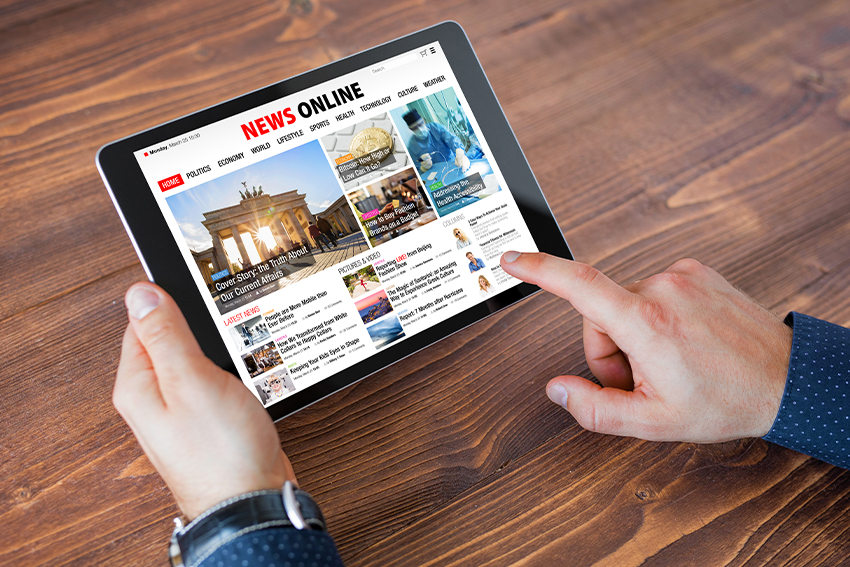The Influence of Social Media Site en route We Take In News Online
Social media has basically changed news intake. It gives prompt accessibility to info, typically eclipsing standard media outlets. Nevertheless, this fast circulation comes with challenges. Users deal with the danger of running into misinformation and coming to be caught in echo chambers. The formulas driving individualized web content can obscure varied point of views. As these dynamics advance, comprehending their implications comes to be crucial for notified engagement in public discourse. What strategies might assist browse this complicated landscape?
The Advancement of News Usage in the Digital Age
As modern technology advanced, the method people consumed news changed considerably in the digital age (stnews.live). Traditional newspapers and relayed media began to decrease as the web became a main resource of info. Online systems provided instantaneous access to newspaper article, video clips, and podcasts, allowing users to stay educated at any kind of time. The comfort of mobile phones better accelerated this shift, enabling customers to get updates on the move
Furthermore, the surge of news aggregators and internet sites facilitated the usage of varied point of views, empowering users to customize their news intake based on individual interests. This evolution additionally prompted wire service to adapt their methods, concentrating on electronic content and interesting readers through multimedia formats. Because of this, the standard barriers of time and room in news delivery decreased, causing an extra immediate and individualized news experience for audiences worldwide.
The Role of Social Network Platforms in News Distribution
Social media site systems have changed news distribution by offering instant access to info. Their algorithm-driven web content curation commonly focuses on interaction over accuracy, causing considerable credibility difficulties (stnews.live). As individuals navigate this landscape, the ramifications for news intake and public discussion become increasingly complicated
Instant News Gain Access To
Standard news electrical outlets have long been the key resource of details, the rise of social media systems has actually significantly transformed exactly how news is accessed and eaten. Instantaneous news accessibility has become a hallmark of the electronic age, allowing customers to obtain updates in genuine time. Platforms such as Twitter, Facebook, and Instagram allow news to spread swiftly, typically going beyond conventional media in rate and reach. Individuals can share stories, remark on occasions, and engage with reporters, developing a vibrant communication in between the audience and news material. This immediacy cultivates a culture of necessity, triggering customers to look for info promptly. Consequently, the expectation for prompt news has actually improved journalistic practices, compelling news companies to adjust their approaches to fulfill the needs of a busy digital atmosphere.
Algorithm-Driven Material
While individuals proactively engage with web content on social networks, the algorithms that control these platforms play an essential function in figuring out which news stories acquire visibility. These formulas analyze individual actions, choices, and involvement metrics to curate individualized news feeds. Consequently, particular stories may be enhanced while others remain rare, often prioritizing marvelous or trending subjects over substantive coverage. This discerning direct exposure forms customers' understandings of existing events and influences public discourse. The dependence on algorithm-driven web content can create resemble chambers, where individuals are primarily exposed to point of views that straighten with their very own ideas. Consequently, the dynamics of news distribution on social media sites platforms significantly impact exactly how individuals eat and analyze information in the digital age.

Integrity Difficulties
As individuals increasingly turn to social networks for news, the credibility of information run into on these platforms comes to be a pushing problem. The decentralized nature of social networks permits any individual to release web content, typically blurring the lines in between reputable journalism and misinformation. Formulas focus on engagement over precision, causing the extensive circulation of marvelous or deceptive stories. This setting positions considerable challenges for customers trying to recognize reliable sources. Social media site platforms, while seeking to deal with misinformation with fact-checking and content small amounts, run the gauntlet for variances and prejudices in their strategies. Ultimately, the duty lies with customers to critically evaluate the news they eat, as the fast spread of info frequently outpaces confirmation initiatives by platforms.
The Surge of Citizen Journalism and User-Generated Content
The rise of person journalism has actually encouraged day-to-day individuals to share news and perspectives, typically offering insights that standard media may overlook. However, this shift additionally presents significant challenges, specifically the spread of false information that can occur from unverified material. As user-generated material ends up being extra common, the equilibrium in between genuine voices and precision in coverage continues to be a crucial issue.
Encouraging Everyday Voices

Challenges of False information
While the surge of citizen journalism has opened methods for varied voices in the media landscape, it has actually likewise introduced substantial challenges connected to misinformation. The convenience of sharing information with social media sites platforms allows individuals to disseminate news promptly, however this fast spread usually comes at the expense of accuracy. User-generated web content frequently lacks the rigorous fact-checking and content oversight that standard journalism supplies. Sensationalized or false narratives can get traction, misdirecting audiences and shaping public understanding. In addition, the blending of viewpoint and fact within social media complicates the difference between legitimate details and misinformation. Because of this, customers must navigate an increasingly complex media atmosphere, requiring critical assuming skills to discern trustworthy news sources among the sound

False information and Its Implications for Public Discussion
As social networks systems significantly control the landscape of information circulation, the expansion of false information presents considerable challenges for public discussion. False information, typically developed to misdirect or prompt psychological reactions, can distort perceptions of fact and weaken count on in trustworthy resources. This phenomenon brings about polarized viewpoints, as people move towards echo chambers that strengthen their beliefs, further lodging divisions within culture.
The ramifications for public discourse are extensive. When residents depend on incorrect info, purposeful dialogue decreases, and the autonomous process suffers. False information can prompt anxiety and complication, affecting public health and wellness, safety and security, and political security. Therefore, fostering media proficiency comes to be essential, empowering individuals to seriously examine info and determine truth from fiction. Addressing the challenges postured by misinformation is essential for preserving the honesty of public discussion and making sure a knowledgeable people qualified of engaging in useful conversations.
The Influence of Formulas on News Presence
Provided the main function of algorithms in determining material exposure, their influence on news intake is profound. These algorithms, used by social networks platforms, prioritize particular kinds of material based on individual interaction and preferences. As a result, news write-ups that line up with prominent trends or target market passions are more most likely to be presented plainly, while less astonishing stories might be overlooked. This creates an atmosphere where customers are revealed mostly to info that reinforces their point of views, possibly causing resemble chambers.
Additionally, the consistent development of formulas suggests that news organizations need to adjust their techniques to line up with these transforming parameters, frequently focusing on clickbait or psychologically billed headings. The honesty of news coverage can go to this website be compromised, as critical tales may not obtain the visibility they deserve. The mathematical shaping of news exposure consequently plays a necessary duty in influencing public understanding and understanding of present occasions.
The Shift Toward Visual Narration in News Media
Progressively, news media is embracing aesthetic narration as a powerful tool to engage audiences. This method leverages images, video clips, infographics, and interactive components to share information better than typical text-based styles. As focus covers shorten, visuals provide a quick, impactful way to connect intricate stories and order audiences' rate of interest.
Systems like Instagram and TikTok have additional increased this trend, engaging news organizations to adjust their material approaches to fit these visually-driven click for info settings. By integrating engaging visuals, news electrical outlets can boost psychological links and foster higher understanding of topical concerns.
Aesthetic narration permits for even more varied stories, showcasing several perspectives through dynamic discussions. As target markets progressively take in news with mobile tools, the shift towards visuals not only caters to user preferences but also assists to break down obstacles to details gain access to. Inevitably, this development shows a broader transformation in exactly how news is generated and eaten in the electronic age.
Future Trends: Browsing the Changing Landscape of News Consumption
While the electronic landscape remains to progress, news usage is poised for significant improvement driven by emerging innovations and altering target market behaviors. As expert system and equipment understanding advance, individualized news feeds will certainly come to be a lot more prevalent, allowing users to get material customized to their passions. This modification might lead to higher involvement but likewise elevate problems regarding resemble chambers and false information.
Additionally, the increase of voice-activated tools and smart speakers will influence just how news is supplied, changing the emphasis from aesthetic to acoustic formats. This pattern might urge news companies to embrace more succinct and appealing audio content.

Frequently Asked Inquiries
Just How Do Social Network Communications Affect News Reputation?
Social media interactions can considerably influence perceptions of news integrity. Involvement metrics, such as sort and shares, commonly form target market trust fund, with popular blog posts acquiring regarded legitimacy, regardless of the precision or reliability of the information presented.
What Function Do Influencers Play in Shaping News Narratives?
Influencers considerably form news stories by leveraging their systems to amplify specific stories, usually customizing web content to their audience. This can result in prejudiced perspectives, affecting public understanding and prioritizing sensationalism over factual coverage.
How Can Users Identify Reliable News Resources on Social Media Site?
Individuals can recognize dependable news sources on social media by inspecting the resource's credibility, verifying truths with several electrical outlets, examining the professionalism and trust of the web content, and recognizing possible prejudices in reporting to assure accurate information.
What Influence Does Social Media Site Have on Typical Journalism Jobs?
Social network significantly impacts standard journalism tasks by changing revenue versions, check lowering demand for print media, and cultivating competition from person reporters. Consequently, many specialists encounter task instability and have to adapt to swiftly transforming media landscapes.
Exactly How Do Different Demographics Consume News on Social Network?
Different demographics display different choices for news intake on social media sites. More youthful target markets prefer systems like TikTok and Instagram for fast updates, while older individuals tend to like Twitter and facebook for extra in-depth discussions and articles.